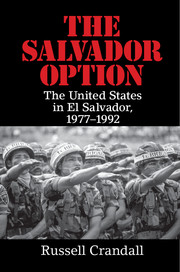Book contents
- Frontmatter
- Dedication
- Epigraph
- Contents
- List of Figures
- List of Organizations
- Acknowledgments
- 1 Introduction
- PART ONE EL SALVADOR IN THE COLD WAR
- PART TWO JIMMY CARTER
- PART THREE RONALD REAGAN
- PART FOUR GEORGE H. W. BUSH
- 39 Elusive Justice
- 40 Pessimism
- 41 Bush Arrives
- 42 Bush, Cristiani, and the 1989 Vote
- 43 Guerrilla Second Final Offensive, November 1989
- 44 Jesuit Killings
- 45 SAMs
- 46 United Nations and Peace
- 47 Demobilization
- PART FIVE POSTWAR
- Notes
- Bibliography
- Index
46 - United Nations and Peace
from PART FOUR - GEORGE H. W. BUSH
Published online by Cambridge University Press: 05 June 2016
- Frontmatter
- Dedication
- Epigraph
- Contents
- List of Figures
- List of Organizations
- Acknowledgments
- 1 Introduction
- PART ONE EL SALVADOR IN THE COLD WAR
- PART TWO JIMMY CARTER
- PART THREE RONALD REAGAN
- PART FOUR GEORGE H. W. BUSH
- 39 Elusive Justice
- 40 Pessimism
- 41 Bush Arrives
- 42 Bush, Cristiani, and the 1989 Vote
- 43 Guerrilla Second Final Offensive, November 1989
- 44 Jesuit Killings
- 45 SAMs
- 46 United Nations and Peace
- 47 Demobilization
- PART FIVE POSTWAR
- Notes
- Bibliography
- Index
Summary
We had to face the reality that we could not win.
– Gerson Martínez, FMLN commanderIt's time to shed the myths about El Salvador, and come together behind a bipartisan policy based upon the truth.
– Bernard Aronson, Assistant Secretary of State, October 1990Cristiani deserves a gold medal, I respect him. He has done a great service to the country.
– Salvadoran guerrilla, 1992“The United States Would Not Abandon El Salvador”
As we saw, the FMLN's stunning November 1989 military offensive led many observers to conclude, not illogically, that the FAES was in dire straits. Less reported, though, was that Washington's restoration of tens of millions of dollars in military aid amid the fallout from the Sandinista-delivered SAM revelations proved to be a blow to the FMLN's chest. What is more, the Pentagon displayed some saber rattling in an attempt to disabuse the Salvadoran rebels from any notion that Washington had forsaken its client military in El Salvador. According to the U.S. Southern Command commander General George Joulwan, the renewed aid transformed the FAES into a different fighting force: “[From January 1991] they went to the field, and stayed in the field. They took the fight to the enemy but did it right, to include respect for human rights.” Moreover, Joulwan contended that the FMLN's increasingly lethal use of sophisticated weaponry – especially the SA-14 man-portable air defense missiles (MANPADs) – was now effectively countered by the expedited delivery of replacement aircraft and materiel. At one equipment transfer ceremony at Ilopango Air Base, Joulwan even publicly warned the FMLN that each FAES aircraft they destroyed would be replaced. Joulwan also sent training teams to El Salvador to teach maneuvers on evading ground-launched missiles. The net effect, Joulwan contended, was to show the FMLN that “the United States…would not abandon El Salvador, and would support the democratic government of Cristiani.”
Joulwan's sense of the FAES's improving combat abilities despite the 1989 guerrilla offensive debacle was coupled with the Sandinista's largely unexpected electoral defeat in 1990 that removed the FMLN's closest ally from power in Managua.
- Type
- Chapter
- Information
- The Salvador OptionThe United States in El Salvador, 1977–1992, pp. 461 - 471Publisher: Cambridge University PressPrint publication year: 2016

